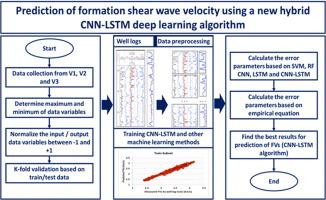利用一种新的混合深度学习算法预测地层横波速度
IF 4.1
3区 地球科学
Q2 GEOSCIENCES, MULTIDISCIPLINARY
引用次数: 0
摘要
油藏、钻井、地质和岩石物理工程师严重依赖地层横波速度(fv),然而传统的获取fv的方法通常既耗时又昂贵。利用人工智能(AI)可以提供更高效、更准确的预测。在这项研究中,利用来自中东气田三口井的8670个数据集,开发了一种将卷积神经网络(CNN)与长短期记忆(LSTM)网络相结合的新型混合方法,用于FVs预测。该方法首次应用于地球物理领域,可有效捕获测井曲线与输入/输出数据之间的时间关系,显著提高预测精度。Pearson相关分析显示,fv与测量深度(MD)、井径(cP)、浅层电阻率(RES-SHT)、密度(RHOB)和地层压力波速(FVp)呈负相关。相反,与深部电阻率(RES-DEP)、伽马射线(GR)、孔隙率(NPHI)和介质电阻率(RES-MED)呈正相关。较高的RES-DEP、cP、GR、RES-SHT和FV值与较高的FV估计值相关。CNN-LSTM混合模型优于其他算法,在应用于另一口井(V3)时保持了较高的精度,从而证明了其在横波速度预测方面的鲁棒性和有效性。这种双重架构——将CNN的空间特征提取能力与LSTM的时间依赖性建模能力相结合——巩固了模型的稳定性、适应性和对广泛的地球物理研究的适用性。本文章由计算机程序翻译,如有差异,请以英文原文为准。

Prediction of formation shear wave velocity using a new hybrid deep learning algorithm
Reservoir, drilling, geology, and petrophysics engineers rely heavily on formation shear wave velocity (FVs), yet traditional methods for obtaining FVs are often time-consuming and costly. Leveraging artificial intelligence (AI) offers the potential for more efficient and accurate predictions. In this study, a novel hybrid approach integrating a convolutional neural network (CNN) with a long short-term memory (LSTM) network was developed for FVs prediction, utilizing 8670 datasets from three wells in a Middle Eastern gas field. This method, the first of its kind applied to geophysical applications, effectively captures the temporal relationships between well logs and input/output data, significantly enhancing prediction accuracy. Pearson correlation analysis reveals negative correlations between FVs and measured depth (MD), caliper (cP), shallow resistivity (RES-SHT), density (RHOB), and formation pressure wave velocity (FVp). In contrast, positive correlations are observed with deep resistivity (RES-DEP), gamma ray (GR), porosity (NPHI), and medium resistivity (RES-MED). Elevated RES-DEP, cP, GR, RES-SHT, and FVs values are associated with higher FV estimates. The CNN-LSTM hybrid model outperforms other algorithms, maintaining high accuracy when applied to an additional well (V3), thereby demonstrating its robustness and effectiveness for shear wave velocity prediction. The dual architecture—combining CNN's spatial feature extraction capabilities with LSTM's ability to model temporal dependencies—underpins the model's stability, adaptability, and applicability to a wide range of geophysical studies.
求助全文
通过发布文献求助,成功后即可免费获取论文全文。
去求助
来源期刊

Physics and Chemistry of the Earth
地学-地球科学综合
CiteScore
5.40
自引率
2.70%
发文量
176
审稿时长
31.6 weeks
期刊介绍:
Physics and Chemistry of the Earth is an international interdisciplinary journal for the rapid publication of collections of refereed communications in separate thematic issues, either stemming from scientific meetings, or, especially compiled for the occasion. There is no restriction on the length of articles published in the journal. Physics and Chemistry of the Earth incorporates the separate Parts A, B and C which existed until the end of 2001.
Please note: the Editors are unable to consider submissions that are not invited or linked to a thematic issue. Please do not submit unsolicited papers.
The journal covers the following subject areas:
-Solid Earth and Geodesy:
(geology, geochemistry, tectonophysics, seismology, volcanology, palaeomagnetism and rock magnetism, electromagnetism and potential fields, marine and environmental geosciences as well as geodesy).
-Hydrology, Oceans and Atmosphere:
(hydrology and water resources research, engineering and management, oceanography and oceanic chemistry, shelf, sea, lake and river sciences, meteorology and atmospheric sciences incl. chemistry as well as climatology and glaciology).
-Solar-Terrestrial and Planetary Science:
(solar, heliospheric and solar-planetary sciences, geology, geophysics and atmospheric sciences of planets, satellites and small bodies as well as cosmochemistry and exobiology).
 求助内容:
求助内容: 应助结果提醒方式:
应助结果提醒方式:


